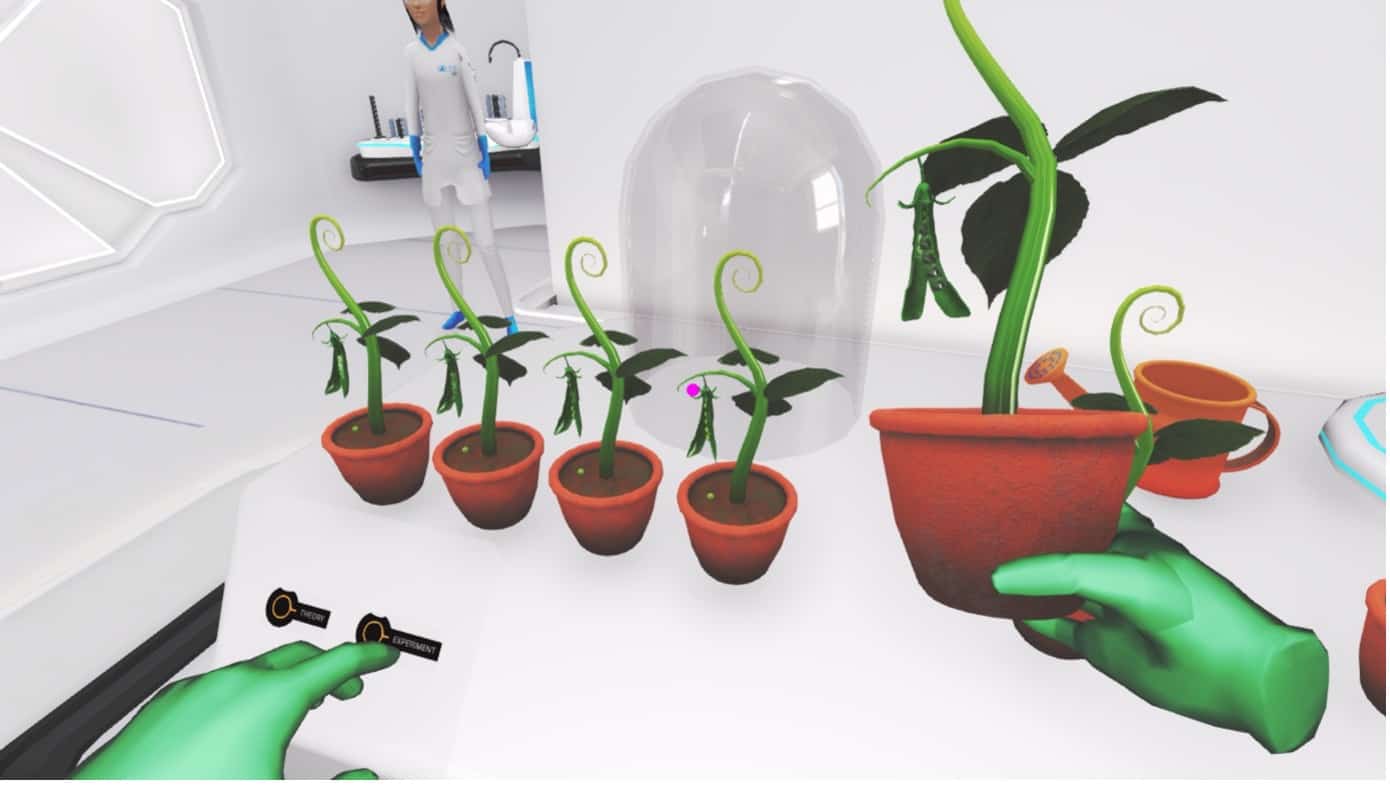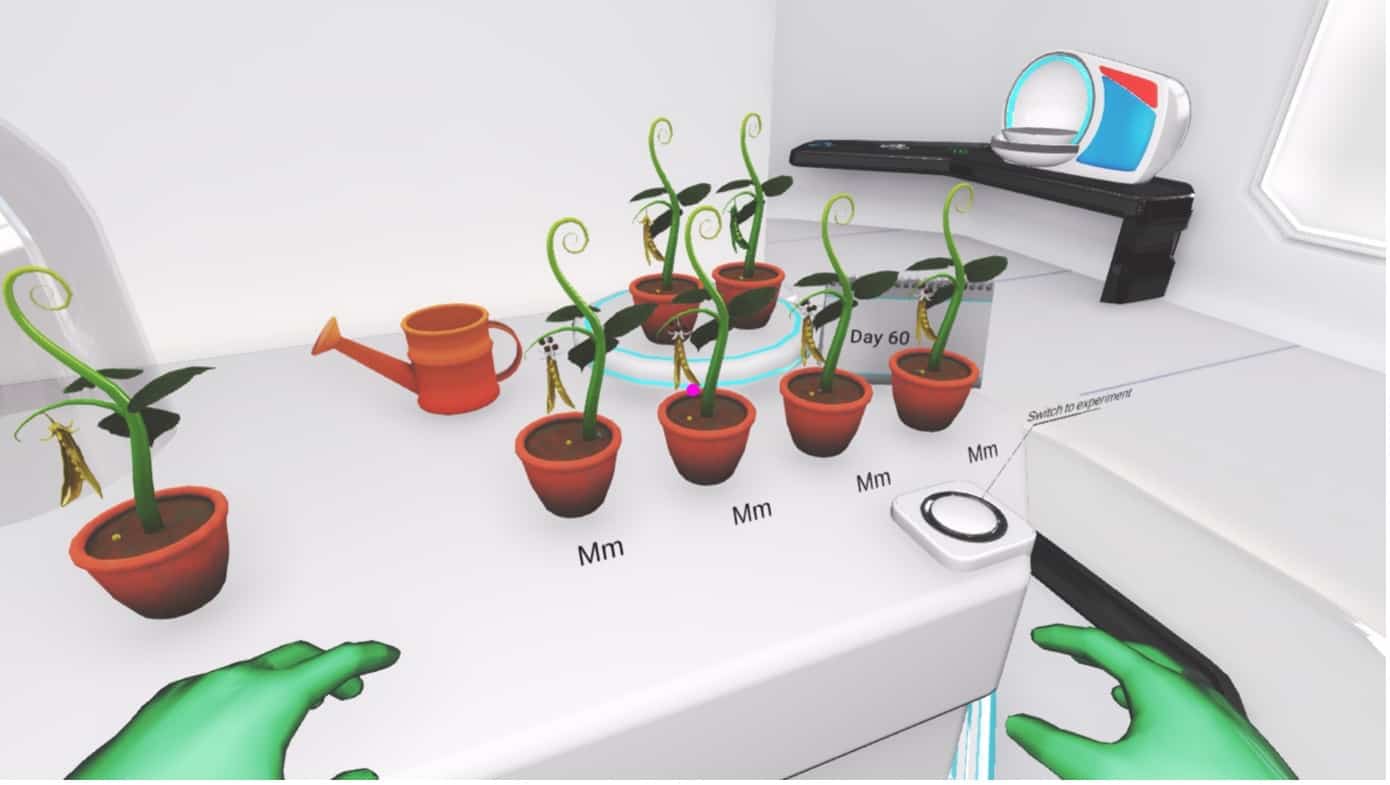Johann Gregor Mendel (1822–1884), also known as the "father of genetics", was a teacher and scientist. Mendel worked under harsh conditions while making some of the most important discoveries in biology. In 1856, Mendel began a project in which he would investigate patterns of inheritance. Although he started his research using mice, he later switched to honeybees and plants, eventually deciding on peas as the main model organism.
Mendel studied the inheritance of seven different traits in peas, including size, flower colour, seed color and seed shape. In order to do this, he first classified the pea sprouts with two different characteristics, such as tall and short stature. He bred these pea sprouts for generations until he had pure offspring (always producing offspring similar to the parent), and then crossed these pure offspring with each other to study how traits were inherited.
Each time in the first generation after the cross he saw that one form of one trait overwhelms the other; such as length and shortness. Mendel called the apparent form the dominant traitand the latent form the recessive trait.
Mendel shared the results of his experiments on approximately 30,000 pea plants with the Natural History Society in 1865. Based on the patterns he observed, the data he collected, and the mathematical analysis of his results, Mendel proposed an inheritance model that includes:
- Characters such as flower color, plant height, and seed shape are controlled by dual factors, which are in different versions and can be passed on to future generations.
- One version of the factor (dominant form) may hide the presence of the other version (recessive form).
- Paired agents are separated during gamete production, so each gamete (sperm or egg) receives only one agent at random.
- Factors controlling different characters are inherited independently of each other.
Mendelian pea experiment is an important experiment for students to distinguish between phenotype and genotype, to understand monohybrid concept and genetic theory. However, in real life, it takes months for genetic analysis of next generations. For this reason, it cannot be possible for students to do it during school time.
On the other hand, Mendel and his peas experiment can be done in a few minutes in virtual laboratory. Students can do the genetic experimentation of different traits such as colour and shape in a short time.

The student can observe which feature is dominant over which feature by selecting the peas they want. After pollinating the peas, they take the off springs and germanite them. By this way, students can learn phenotypes and genotypes concepts.

The result of Mendel and his peas experiment indicate that the frequency of a trait in the second generation is always predictable if we know the frequencies in the first generation, even though we cannot explain why this phenomenon occurs. At the same time, students can have their own interpretations about each case, which means there are many opportunities for them to develop their critical thinking skills. In front of this technology education tool, students should not just be open-minded but also trust themselves on making science experiments by themselves and interpreting based on logics. Through VRLab Academy, students can have hands-on experience with a virtual plant lab in VRLab Academy that shows what Mendelian pea experiments are all about. They can learn much the same way Gregor Mendel did, using basic scientific principles to do real genetics work. They can do the same experiment a number of times, or try out different versions. This way, you will get new experiences and acquire new knowledge. This is an experiment that changes the world for students!
Take a look at all experiments at VRLab Academy andenhance your teaching power with us.
Why were Mendel's findings initially ignored by the scientific community?
Mendel's groundbreaking findings were initially ignored by the scientific community primarily because they were far ahead of the prevailing ideas surrounding heredity and variation during his time. Considering that Mendel conducted his experiments and published his work in 1866, his concepts and conclusions were revolutionary and went against the widely accepted beliefs of that era. Right after the publication of “Origin of Species” by Charles Darwin in 1859, inheritance and evolution were subjects of high controversy.
The scientific community's lack of acknowledgment can be attributed to a combination of factors, including the lack of awareness regarding the significance of his research and the scientific community's resistance to accepting new, unfamiliar ideas. It was only in the early 1900s, several decades after Mendel's death in 1884, that his work finally received the recognition it deserved. As the field of biology advanced and more scientists began to explore the principles of inheritance, three plant biologists independently rediscovered Mendel's work and acknowledged its significance.
How did Mendel continue his experiments with peas?
After initially cross-breeding different varieties of peas, Mendel didn't stop there. He went on to engage in a continuous process of self-pollination with the pea plants over several years. This involved allowing the plants to reproduction without any external intervention, enabling them to naturally fertilize themselves. Throughout this period, Mendel meticulously observed and recorded the various characteristics exhibited by the offspring. To ensure a comprehensive and reliable dataset, it is estimated that he grew an extensive number of pea plants, possibly reaching up to 30,000, consistently dedicating a prolonged span of 7 years to his experiments.
What experiments did Mendel conduct at the monastery?
Mendel conducted a series of experiments at the monastery to investigate the mechanisms of inheritance in different generations. His focus was on examining the traits that are passed from one generation to another. To carry out his experiments, Mendel selected peas (Pisum sativum) as his chosen plant species. The reason behind this choice was that peas had been previously used for similar studies and possessed several advantageous features for experimentation. The primary advantages of using peas were their ease of cultivation and the ability to sow them each year. Another important characteristic of pea plants is that their flowers possess both male and female parts, known as stamen and stigma. Pea flowers have the ability to self-pollinate, meaning that the plant can produce offspring from just one individual. Self-pollination occurs even before the flowers open, increasing the possibility of obtaining progeny from a single plant. In addition to self-pollination, Mendel also explored the potential of cross-pollination in peas. By manually opening the flower buds and removing the pollen-producing stamen, he prevented self-pollination. Then, he proceeded to dust the pollen from one pea plant onto the stigma of another plant, effectively facilitating cross-pollination. This approach allowed Mendel to study the inheritance patterns resulting from the crossing of different pea plants with specific traits. Through these experiments, Mendel made groundbreaking discoveries about inheritance and established the foundation for the field of genetics.
How did Mendel become the "father of modern genetics"?
Mendel earned the title of the "father of modern genetics" due to his groundbreaking contributions to the field of inheritance and his extensive study of pea plants. As a monk and teacher, Mendel possessed a keen interest in astronomy and plant breeding, which led him to join a monastery in Br?nn and embark on a series of experiments focused on understanding how traits are passed down from one generation to the next. Inspired by previous studies that had utilized peas for similar purposes and their advantageous characteristics of easy cultivation and annual sowing, Mendel chose them as his primary subjects of investigation. Through meticulous experimentation, he made a pivotal discovery that traits are inherited independently, and he further classified each variant of a trait as either dominant or recessive. Mendel's work, despite its initial lack of recognition, laid the very foundation of modern genetics. His thorough exploration and systematic approach to elucidating the principles of inheritance provided invaluable insights into the mechanisms governing the passage of traits from parents to offspring. By demonstrating the independent assortment of traits and introducing the concept of dominant and recessive inheritance, Mendel revolutionized our understanding of genetic patterns. The significance of Mendel's contributions became truly apparent after his work was rediscovered and further expanded upon by subsequent scientists. Today, his discoveries remain at the core of genetic research and have paved the way for countless breakthroughs and advancements in the field. Mendel's unwavering dedication to his experiments and his keen observational skills have undoubtedly earned him the well-deserved title of the "father of modern genetics".
References:
https://cnx.org/contents/N23wBdBB@1.1:FYmHBZ4Q@1/Mendelian-Genetics-Probability-GPC
Gasking, E. B. (1959). Why was Mendel’s Work Ignored? Journal of the History of Ideas, 20(1), 60–84. https://doi.org/10.2307/2707967